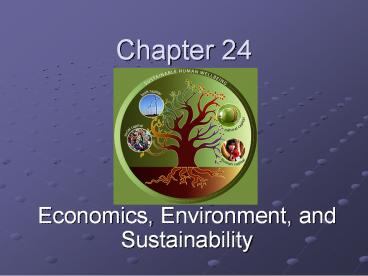Economics, Environment, and Sustainability - PowerPoint PPT Presentation
1 / 25
Title: Economics, Environment, and Sustainability
1
Chapter 24
- Economics, Environment, and Sustainability
2
Economic Resources The Big Three
- Three types of resources are used to produce
goods and services.
Figure 24-2
3
What is an ecological economist?
- One who studies the inter-dependence and
coevolution between human economics and their
natural ecosystems
4
Ecological economists base their models on the
following assumptions
- Resources are limited and should not be wasted.
- We should encourage environmentally beneficial
and sustainable forms of economic development. - The harmful environmental and health effects of
producing goods and services should be included
in their market price.
5
EARTH
Suns
capital
Economic Systems
Heat
Depletion of nonrenewable resources
Production
Natural Capital
Air, water, land, soil, biodiversity, minerals,
raw materials, energy resources dilution,
decomposition, recycling services
Degradation depletion of renewable resources
used faster than replenished
Consumption
Pollution, waste from overloading natures waste
disposal recycling systems
Recycling and reuse
Fig. 24-4, p. 573
6
Characteristic
Unsustainable Economic Growth
Environmentally Sustainable Economic Development
Production emphasis
Quantity
Quality
Natural resources
Not very important
Very important
Resource productivity
Inefficient (high waste)
Efficient (low waste)
Resource throughput
High
Low
Resource type emphasized
Nonrenewable
Renewable
Resource fate
Matter recycled, reused, or composted
Matter discarded
Pollution control
Cleanup (output reduction)
Prevention (input reduction)
Guiding principles
Riskbenefit analysis
Prevention and precaution
Fig. 24-5, p. 573
7
ESTIMATING THE VALUE OF ECOLOGICAL SERVICES AND
MONITORING ENVIRONMENTAL PROGRESS
- Economists have developed several ways to
estimate nonmarket values of the earths
ecological services based using - Mitigation cost how much it takes to offset any
environmental damage. - Willingness to pay determine how much people are
willing to pay to keep the environment in tact
(e.g. protect an endangered species).
8
Cost-Benefit Analysis a Useful but Crude Tool
- Comparing likely costs and benefits of an
environmental action is useful but involves many
uncertainties. - ????????????????????
9
Costbenefit analyses involves determining
- Who or what might be affected by a particular
regulation or project. - Projecting potential outcomes.
- Evaluating alternative actions.
- Establishing who benefits and who is harmed.
10
- If costs exceed benefit, then the proposed action
is rejected. - If benefits exceed cost, the proposed action is
accepted. - If cost benefit, then a decision has to be made
whether to start or stop the proposed action
11
What is GNP?
- The sum of all goods and services produced by a
country in a given time frame. - For example GNP includes Coca Cola bottled
overseas but not Toyotas made in the United
States (the profit is still going to the Japanese)
12
Environmental and Economic Indicators
Environmental Radar
- We need indicators that reflect changing levels
of environmental quality and human health. - Gross domestic product (GDP) measures the annual
economic value of all goods and services produced
in a country without taking harmful effects into
consideration. - Includes Toyotas made in the United States but
not Coca Cola bottled overseas.
13
What is GPI?
- Genuine Progress Indicator
- The GPI subtracts from the GDP costs that lead to
a lower quality of life or deplete/degrade
natural resources. - Kind of a way to see if the economic growth has
benefited people overall
14
Environmental and Economic Indicators
Environmental Radar
- Comparison of the per capita GDP and the GPI in
the U.S. between 1950 and 2002.
Figure 24-8
15
What are external costs?
- External cost refers to something that a business
does that is not included in its profit and loss
(pollution for example). - The business may be responsible for cleaning up
its mess. - Examples are Superfund sites, Shoreham nuclear
power plant, Love Canal, PCBs in the Hudson
River and General Electric.
16
ECONOMIC TOOLS FOR IMPROVING ENVIRONMENTAL QUALITY
- Including external costs in market prices informs
consumers about the harmful impact of their
purchases the earths life-support systems and on
human health.
17
Eco-Labeling Informing Consumers So They can
Vote with Their Wallets
- Certifying and labeling environmentally
beneficial goods and resources extracted by more
sustainable methods can help consumers decide
what goods and services to buy.
Figure 24-9
18
How do we make the right choice for our wallet
and the environment?
19
Trade-Offs
Environmental Taxes and Fees
Advantages
Disadvantages
Helps bring about full-cost pricing
Penalizes low income groups unless safety nets
are provided
Provides incentive for businesses to do better to
save money
Hard to determine optimal level for taxes and fees
Need to frequently readjust levels, which is
technically and politically difficult
Can change behavior of polluters and consumers if
taxes fees are set at a high enough level
Govts may see this as a way of increasing
general revenue instead of using funds to improve
environmental quality and reduce taxes on income,
payroll, profits
Easily administered by existing tax agencies
Fairly easy to detect cheaters
Fig. 24-10, p. 580
20
What are Green Taxes?
- Taxing wages and profits less and pollution and
waste more.
Figure 24-11
21
Advantages of green taxes
- Decreases depletion and degradation of natural
resources - Encourages waste reduction and pollution
prevention - Rewards recycling and reuse
- Stimulates creativity in solving environmental
problems to avoid paying extra
22
Jobs, Profits, and the Environment New
Industries and New Jobs
- Shifting to more environmentally sustainable
economies will create immense profits and huge
numbers of jobs.
Figure 24-16
23
Examples of some environmentally sustainable
careers
- Aquaculture
- Biofuels
- Energy efficient product design
- Environmental Education
- Environmental Law
- Environmental Consulting
- Environmental Engineering
- Wind energy
24
Pollution and Public Policy
- Steps in policy development in response to a
human or environmental problem
25
- Recognition admitting there is a problem
- Formulation coming up with a solution
- Implementation putting a plan into action
- Control making sure people adhere to the plan































